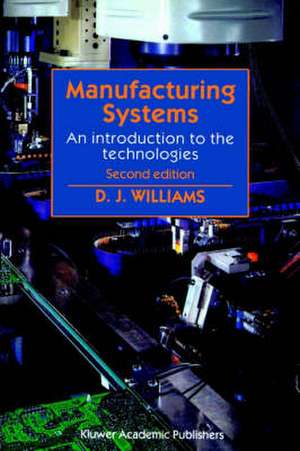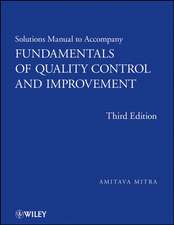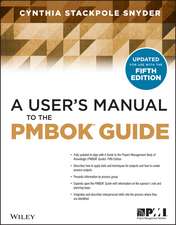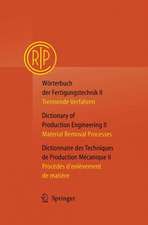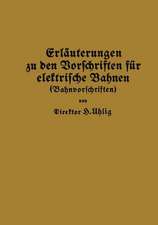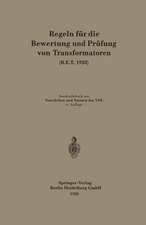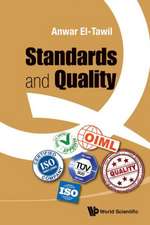Manufacturing Systems
Autor D.J. Williamsen Limba Engleză Paperback – 30 sep 1994
| Toate formatele și edițiile | Preț | Express |
|---|---|---|
| Paperback (2) | 386.00 lei 6-8 săpt. | |
| Springer Us – 30 iun 1988 | 386.00 lei 6-8 săpt. | |
| SPRINGER NETHERLANDS – 30 sep 1994 | 638.76 lei 6-8 săpt. |
Preț: 638.76 lei
Preț vechi: 751.47 lei
-15% Nou
Puncte Express: 958
Preț estimativ în valută:
122.23€ • 128.53$ • 100.99£
122.23€ • 128.53$ • 100.99£
Carte tipărită la comandă
Livrare economică 17 aprilie-01 mai
Preluare comenzi: 021 569.72.76
Specificații
ISBN-13: 9780412605802
ISBN-10: 0412605805
Pagini: 268
Ilustrații: 268 p.
Dimensiuni: 155 x 235 x 15 mm
Greutate: 0.37 kg
Ediția:1994
Editura: SPRINGER NETHERLANDS
Colecția Springer
Locul publicării:Dordrecht, Netherlands
ISBN-10: 0412605805
Pagini: 268
Ilustrații: 268 p.
Dimensiuni: 155 x 235 x 15 mm
Greutate: 0.37 kg
Ediția:1994
Editura: SPRINGER NETHERLANDS
Colecția Springer
Locul publicării:Dordrecht, Netherlands
Public țintă
ResearchRecenzii
Reviews for 1st edition: The treatment of the subject is at all times comprehensive...and will help to further the readers' understanding of the vast multidisciplinary subject of modern manufacturing technology. - FMS Magazine; ...a key volume for the production engineer. Automotive Engineer; In conclusion I found the book easy to read and it would be a useful starting point for a broad range of computerised manufacturing technologies. - Manufacturing Engineer
Cuprins
1 Introduction — manufacturing systems approaches.- 1.1 Introduction.- 1.2 The structure of the book.- 1.3 Single machines.- 1.4 Cells, assembly and systems.- 1.5 The manufacturing process.- 1.6 Business drives for manufacturing.- 1.7 Manufacturing systems approaches.- 1.8 Top down approaches.- 1.9 Bottom up approaches.- 1.10 Automation and people.- 2 More conventional approaches to factory layout.- 2.1 Introduction.- 2.2 Traditional factory layouts.- 2.3 Static build.- 2.4 Process-based layout.- 2.5 Product-based layouts.- 2.6 Techniques of factory layout.- 2.7 More recent advances on traditional approaches.- 2.8 Group technology.- 2.9 Dedicated automation.- 2.10 Kanban.- 3 The machining centre — a servo-controlled machine tool.- 3.1 Introduction.- 3.2 Feedback control.- 3.3 The horizontal machining centre.- 3.4 Constraints on the operation of machine tools.- 3.5 Elastic and thermal effects in machine tools.- 3.6 Regenerative chatter in machine tools.- 3.7 Programmable processes.- 4 The robot — a handling device, a manipulator.- 4.1 Introduction.- 4.2 A definition of the industrial robot.- 4.3 Discussion of the definition.- 4.4 Robot types.- 4.5 Robot construction.- 4.6 Manipulation with robots.- 4.7 The robot skeleton.- 4.8 Cartesian-to-Joint-Space transformation.- 4.9 The practical application of robots.- 4.10 Grippers.- 4.11 Sensory robots.- 5 Sensing.- 5.1 Sensors for manufacturing.- 5.2 Sensors to monitor position.- 5.3 Proximity sensors.- 5.4 Tough trigger probes.- 5.5 Tool breakage sensing.- 5.6 Torque and power monitoring.- 5.7 Force sensing.- 5.8 Machine vision.- 5.9 Image generation.- 5.10 Image enhancement.- 5.11 Image processing.- 5.12 Image analysis and object recognition.- 5.13 Use of image information.- 5.14 An example of vision linked with arobot.- 6 Software for single machines.- 6.1 Introduction.- 6.2 Machine tool programming.- 6.3 Manual part programming — machine tool code programming.- 6.4 Computer-assisted part programming.- 6.5 Conversational part programming.- 6.6 NC Programming from a CAD system, CADCAM.- 6.7 Representation of 3D (three-dimensional) shapes.- 6.8 CADCAM and CIM (Computer Integrated Manufacturing).- 6.9 Robot programming.- 6.10 Teach-by-showing.- 6.11 High level languages.- 6.12 Robot programming from CAD systems.- 6.13 Flow of control.- 7 The manufacturing cell — the building block of systems.- 7.1 Introduction.- 7.2 Cells of factory automation.- 7.3 Advantages and disadvantages of cellular approaches.- 7.4 Applications of the cellular philosophy.- 7.5 A prismatic machining cell.- 7.6 A turning cell.- 7.7 Differences between prismatic and rotational cells.- 7.8 A robot welding cell.- 7.9 A cell with automatic changeover.- 7.10 Cell simulation.- 7.11 The Petri net.- 7.12 Cell justification.- 8 Assembly.- 8.1 Introduction.- 8.2 Parts mating theory.- 8.3 Jamming.- 8.4 Wedging.- 8.5 Remote centre compliance.- 8.6 SCARA robots.- 8.7 Design for assembly.- 8.8 Rules for product design.- 8.9 Rules for the design of parts.- 8.10 Manual assembly.- 8.11 Dedicated assembly automation.- 8.12 Programmable assembly automation.- 9 The automated factory and systems.- 9.1 Introduction.- 9.2 Flexibility and reconfigurability.- 9.3 A hierarchical view of manufacturing.- 9.4 Generic elements of manufacturing systems.- 9.5 Direct numerical control.- 9.6 Flexible cells.- 9.7 Flexible transfer lines.- 9.8 A robot transfer line.- 9.9 A CNC machine tool transfer line.- 9.10 A SMD assembly transfer line.- 9.11 Flexible manufacturing systems.- 9.12 A monolithic FMS.- 9.13 Cell based systems.- 9.14Virtual systems.- 9.15 Hybrid systems.- 9.16 People in systems.- 9.17 Simulation in system design.- 9.18 Application areas.- 10 Computer control of manufacturing systems.- 10.1 Introduction.- 10.2 Computer requirements for process control.- 10.3 A multivariable servomechanism.- 10.4 Hierarchical control.- 10.5 Control networks.- 10.6 Interfacing.- 10.7 Data transmission.- 10.8 Open Systems Interconnection (OSI) and LAN’s.- 10.9 Problems with Local Area Networks.- 10.10 Ethernet.- 10.11 Token rings.- 10.12 The Manufacturing Automation Protocol (MAP).- 10.13 Databases in control.- 10.14 Control hierarchy embodiment.- 10.15 Control computer embodiment.- 10.16 Host and mini computers.- 10.17 Microcomputers.- 10.18 Programmable Logic Controllers.- 10.19 Machine controllers.- 10.20 Heterarchic architectures.- 11 System software.- 11.1 Introduction.- 11.2 Software tasks in manufacturing systems.- 11.3 Scheduling.- 11.4 Generation of management information.- 11.5 Part program communication.- 11.6 Data and databases.- 11.7 Interfaces to other sub-systems.- 11.8 Control of closely co-operating machines.- 11.9 Machine monitoring.- 11.10 High level sensor interfaces.- 11.11 Design requirements of real-time languages.- 11.12 Programming languages for system control.- 11.13 Cell control computer languages.- 11.14 Programming Programmable Logic Controllers.- 11.15 Flow of control commands in robots.- 11.16 Rule driven systems.- 11.17 The future.- Further Reading.
